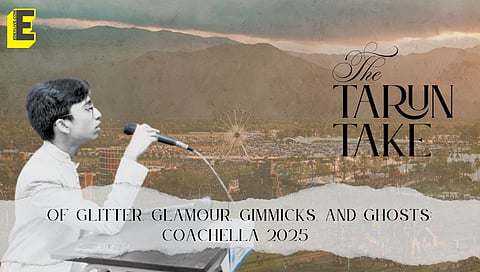

Coachella had taken the world by storm.
So, when I first opened my Instagram feed on April 13 this year, I knew what was coming. I had prepped myself for it, like someone braces before walking into a hurricane of to.
It was the first weekend of Coachella 2025 — a festival thousands of miles away in California, but one that still manages to infiltrate the consciousness of teenagers across the globe like me, sitting in school uniforms on the other side of the world.
One scroll in and I was bombarded. Kendall Jenner in a dress. Doja Cat in fur ensemble. Influencers I’d never heard of, posing like demigods against the desert sun. I was torn between awe and alienation.
How do seventeen-year-old students juggling board exam stress and identity crises compete with that?
That’s when it hit me — Coachella isn’t just a music festival. It’s a giant cog in a culture machine. A hyper-aestheticised runway of curated personas. And for a generation growing up online, it might just be one of the most potent sources of psychological confusion.
The fantasy that hurts
Coachella is the perfect storm of celebrity culture, fast fashion, and digital hysteria.
But what concerns me — and many of my peers — is how easily it transforms into a psychological minefield for adolescents. We’re at the age where our brains are wired for performance. Our sense of self is still forming, and social media often acts like a distorting mirror.
Every glittery photo from Indio feels like it’s demanding something from us: Be more stylish. Be more seen. Be more special.
This is where the theories of adolescent egocentrism — terms I first learned in psychology class — start to feel uncomfortably real.
The "imaginary audience" makes teenagers believe that people are constantly watching and judging them, even when they’re not.
It’s like a rat race. If I don’t post the perfect outfit or keep up with viral aesthetics, am I falling behind in some invisible social race?
And then there’s the "personal fable" — the delusion that our experiences are unique and misunderstood.
It’s not unique, it’s universal. When a boy from South Africa or a girl from Manchester sits in front of their closets, feeling like they have nothing to wear, it’s not just about clothes.
It’s about a deeper sense of lacking, of being disconnected from the fantasy I see online. "They’ll never understand," I tell myself. But who are they?
Turns out, most teenagers are feeling the same way. We just don’t talk about it.
Filters, fringes, and fake freedom
This year’s Coachella fashion was all about contradictions.
Sheer fabrics but concealed truths. Cowboy boots but no sense of grounding. A return to early 2000s Y2K aesthetics that we, ironically, never lived through. Everyone’s playing dress-up, and no one’s quite sure why. I mean, when was the last time they stopped and asked, ‘Why?’.
The festival is also where sustainability takes a backseat. Outfits are worn once for photos and then discarded, the waste masked under aesthetic brilliance.
Brands jump on the bandwagon, launching “festival lines” that only exacerbate fast fashion’s damage. It’s performative liberation — a visual rebellion wrapped in consumerism.
And for those of us watching from the outside, it fuels a dangerous idea: that self-worth is directly proportional to visibility.
The number of likes, the virality of a look, the story reshares. Teenagers begin to dress not for expression, but for perception. We blur the line between who we are and who we want others to think we are.
Real people, unreal expectations
One of my classmates told me she feels “smaller” every time she sees festival content online.
Another joked that Coachella makes her want to move to Mars. These might sound like childish jokes, but they reveal a deeper truth: the constant exposure to curated extravagance chips away at our self-image.
And here’s the irony. Many celebrities are struggling too, trapped in their own cycles of relevance and reinvention. But we don’t see that. We see glow-ups, not burnouts. Highlights, not heartbreaks.
I’m not against Coachella.
It’s a dazzling, dynamic space for music, art, and collective experience. What I’m against is what it’s become: a barometer for self-worth in the teen psyche.
We’re told it’s all about freedom and fun. But freedom isn’t real if it comes with a price tag of comparison, anxiety, and digital exhaustion.
Unfollowing to reconnect
So here’s what I did on Day Two of Coachella: I logged off. Not in a grand, dramatic way. I just put my phone down and went out for a walk.
No filter. No festival. Just the orange gulmohars blooming by my lane and the smell of summer dust in Bhubaneswar during April—short-term for heaven on eart
And it helped.
Because the most radical thing a teenager can do today is choose presence over performance. To look inward instead of outward. To dress for themselves. To create for joy, not for the feed.
Maybe one day I will go to Coachella.
But I hope, when I do, it’s not to be seen — but to see. Not to post, but to be.
(Tarun Tapan Bhuyan is a student studying in SAI International School. Views expressed are his own.)
